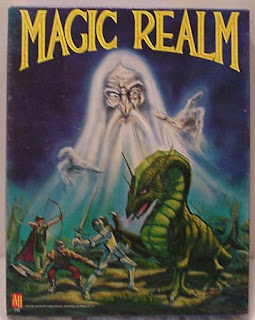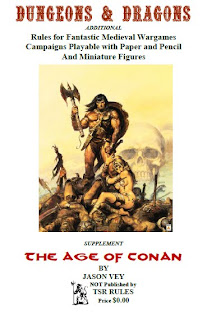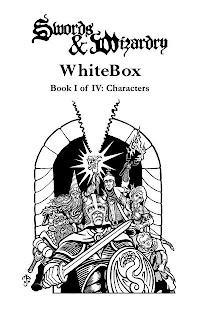
A tip of the hat to Jason Vey, the author of
Spellcraft and Swordplay (S&S). In that game, he both asks, and attempts to answer the question, "what if Dungeons and Dragons had developed from the
Chainmail:rules for medieval miniatures rule-set?"
Few old-schoolers are brave (or foolhardy) enough to try their hand at parsing and restating Chainmail. There are good reasons to avoid that morass. Chainmail includes at least three confusing, competing and irreconcilable matrices for resolving battles: one for mass combat, another for man-to-man combat, and a third for fantastic combat. Chainmail includes contradictory and poorly-written rules. It's mass-combat morale system is needlessly complicated. It even fails to properly define the six major classes of mass-combatants.
I give kudos, then, to Mr. Vey, for attempting the near-impossible. He tries to rescue much of the essence of Chainmail's man-to-man combat system, by bolting it onto a customized D&D-esque role-playing game rule-set.
In addition, Mr. Vey published one iteration of his re-imagined game in a three-booklet format, with rules collected in separate Character, Combat and Creatures booklets. I don't know whether that three-booklet version is still available, but it is a format to my liking, as I prefer to keep the rules, for the moving parts, out of the hands of the players.
While rescuing those Chainmail rules, for employment in his rule-set, Mr. Vey has also chosen to stray somewhat from the original Dungeons and Dragons canon. That choice may have been made, simply to meet certain requirements of the OGL. Changes may also have been made to "improve" or address deficiencies of the original D&D rules. Had I been advising Mr. Vey, I might have suggested keeping a tight rein on any changes, other than for OGL reasons, and adding those as optional rules to the game.
The material in the S&S booklet on Characters approximates the rules found in other D&D rule-books. You have your standard 6 abilities. The four standard classes (F,M,T,C) are there. Hit points are generated by d6 dice-rolls, with pips added to, or subtracted from, your hit-points, based on the character's class. You also have the four standard races.
However, some of the S&S character rules differ, often in unusual ways. For example, Greyhawk's ‘exceptional strength for Fighters’ rule has been included, but exceptional strength is generated by adding a d6-1 roll to any strength of 18. A ‘weapon mastery for Fighters’ rule has also been added, as a standard rule. Magic user spells are acquired by rolling a d3 and adding that number of spells to your repertoire, at even-numbered levels. And the Clerical power to turn undead is limited to once per day, with the undead making morale checks, rather that the Cleric employing the Undead turning table, found in the original D&D rules.
On the other hand, spell-casting rules, from the original Chainmail game, have made their way into the S&S Character booklet. A prime example of this is the spell-success table: as in Chainmail, any time a magic-user casts a spell, she must roll to see if the spell goes into effect immediately, is delayed by one round, or fails utterly. An appropriate nod to Chainmail.
Another Chainmail (and original D&D) rule appearing in S&S: multiple attacks for player characters. Each character has a number of attacks, closely associated with her level. For example, in both S&S and original D&D, they treat a 2nd level Fighter as two regular combatants, for purposes of attacking, using the Chainmail mass-combat table, and both also provide a +1 bonus to her rolls.
Moving on to the S&S Combat booklet, it employs, whole-cloth, the Chainmail man-to-man combat tables. In doing so, Mr. Vey has chosen to ignore the other two (competing) Chainmail combat matrices – the mass-combat and fantastic combat tables. I am sympathetic to that choice, to the extent that the three tables are largely irreconcilable. For example, on the Chainmail mass-combat table, an armored footman has a 16% chance of wounding another armored footman. Now have those same two armored footman (wearing Platemail and wielding morningstars) face off, using the man-to-man combat tables. Suddenly their chances of wounding have increased to 42%.
Similarly, exclusive employment of the man-to-man combat tables allows S&S to avoid the Chainmail ‘fantastic combat’ tables, which preclude Fighters, below 3rd level, from wounding any fantastic creature. Employing the man-to-man combat table, instead, allows 1st and 2nd level players to wound such fantastic monsters as Ogres, Giant insects and Cockatrices. In dispensing with the fantastic combat table, S&S uses a negative modifier to attack rolls instead, to make some fantastic creatures more difficult to hit.
Though I understand the decision to employ only the man-to-man combat table, I think Mr. Vey missed an opportunity to try his hand at reconciling those three combat tables (as impossible as that might appear).
As for the other combat features of S&S, there are several house-rules and modern approaches that have made their way into this rule-set: (limited) exploding dice on critical hits; two dice (use the highest) for two-handed weapon damage; individual initiative. Nothing terribly objectionable here, and some of it is embraced in many house-ruled old-school D&D campaigns. But those could have been added as optional rules, thus maintaining the S&S rules as a Chainmail/OD&D amalgam while still providing optional rules for those who wished to try them out.
S&S also dispenses with the gp = xp rule. Another unusual choice, given the source material, though not too surprising, given that Mr. Vey opines: “the vast majority of fantasy gaming resolves around battles. Swords flashing. Spells blazing, killing things and taking their stuff. That’s what this type of play is geared towards.” Experience is instead doled out for killing monsters, overcoming challenges, and good role-play. Not insignificant achievements, but not entirely in keeping with the exploration and treasure-hunting goals of original D&D.
There are many other features of Chainmail that made their way into S&S. Their inclusion makes this an interesting rule-set to use, for those who would like to see how the game would have played, had Chainmail been a greater influence on the development of D&D. If that is something that interests you, check out Spellcraft and Swordplay.

 Magic Realm could be described as an end-game for Dungeons and Dragons, or a more sophisticated version of the old classic boardgame, Dungeon!, in that the players move around a map-board (in MR's case, Magic Realm is mostly an outdoor adventure, with a few cave-complexes scattered about), encountering each other, monsters, friendly and un-friendly inhabitants, and discovering treasure hoards. Magic Realm is a more sophisticated game than Dungeon!, in that there is a 100-page rule-book, and each character has her own unique strengths and weaknesses, as do the monsters and inhabitants.
Magic Realm could be described as an end-game for Dungeons and Dragons, or a more sophisticated version of the old classic boardgame, Dungeon!, in that the players move around a map-board (in MR's case, Magic Realm is mostly an outdoor adventure, with a few cave-complexes scattered about), encountering each other, monsters, friendly and un-friendly inhabitants, and discovering treasure hoards. Magic Realm is a more sophisticated game than Dungeon!, in that there is a 100-page rule-book, and each character has her own unique strengths and weaknesses, as do the monsters and inhabitants.








 Otherworld Miniatures
Otherworld Miniatures
